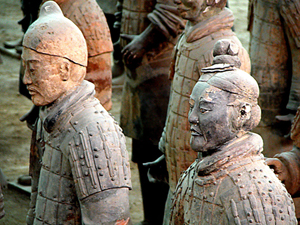
NEW YORK (AFP) – A year ago, China was the sensation of the international art market, but as New York auction houses prepare this week’s autumn sales of Asian works, the Chinese dragon has clearly lost some fire.
“It’s no longer break-neck,” Henry Howard-Sneyd, vice chairman for Asian art at Sotheby’s, told AFP.
“The economy in China is not the crazy growth it was. There’s also a hiatus as we wait for the change in power structures. As always, everyone holds their breath.”
That China’s upcoming Communist Party leadership transition should be part of the reason for dips in the art business is just one indication of complex nuances in the huge sector.
Last year, the Chinese art auction market was said to become the world’s biggest, while the two highest grossing artists were also Chinese: Zhang Daqian and Qi Baishi, with nearly a billion dollars in sales between them.
Figures are sharply down at the major auctions this year, but Howard-Sneyd saw a correction rather than a retreat.
“We see the market as very solid,” he said, with Sotheby’s offering 649 lots with a low estimate of $25,980,200 and a high of $38,856,200.
Highlighting the classical Chinese sale Thursday will be a more than 10-meters-long scroll by Lan Ying, who lived between 1585 and 1664. The intricate landscape is estimated at $1.2-$2.2 million.
A series of Indian contemporary paintings never before at auction, such as M.F. Husain’s seminal Untitled (The Three Muses, Maya Series), estimated at $500,000-$700,000, will be on offer Monday, as will ancient Chinese ceramics and jades on Tuesday and Wednesday.
At Christie’s, Asian art chief Hugo Weihe echoed the mood at Sotheby’s.
“There’s a perception the market has peaked in China,” he said, noting that the slowdown is being accompanied by increasing sophistication.
“There’s more and more focus on the best material. They’re not happy with mediocrity. The market has matured.”
Christie’s hopes to raise about $25 million in its Asia sales throughout the week.
Highlights include the large-scale Untitled (Falling Figure) by India’s Tyeb Mehta, estimated at $600,000-$800,000 on Wednesday, and a green jade Chinese pot from the 18th century, carved with an intricate garden scene, estimated at $500,000-$800,000 in the Thursday and Friday Chinese sale.
Although experts have little doubt that Asia, China in particular, remains the most fertile ground for the industry, they say the challenges are many.
On top of economic and political uncertainty, there’s mistrust about the financial numbers from reported sales within China and the no less slippery problem of authenticating the works themselves.
This is especially difficult with pricey classical works because Chinese artists traditionally learned their skills by copying previous masters.
“Chinese are consummate copiers and fakers,” Howard-Sneyd said.
Another issue plaguing the authenticity is the turmoil of modern Chinese history, meaning “there’s no continuum of ownership,” he added.
Christie’s has an unusual lot aimed exactly at the collector with those worries: a reference library of rare books and catalogs put together by C.T. Loo, a key figure in the international trade of Chinese art in the first half of the 20th century.
With books estimated at between $500 and $15,000, this is an unusual chance for increasingly savvy Chinese collectors to get in a position to do some of their own authenticating.
“The reason we’re seeing a big demand for something like this reference library is that new Chinese collectors haven’t had access to the kind of references we’ve had over here for the last 100 years or so,” said Noah Kupferman, co-head of the Chinese department in New York.
ADDITIONAL IMAGE OF NOTE



